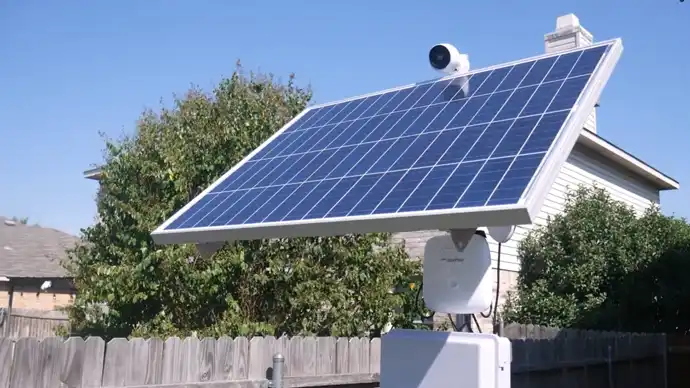Photovoltaic or solar power is a renewable energy source that utilizes the sun’s rays to generate electricity. Along with providing energy for homes and businesses, solar panels are a significant cost saver.
Having security cameras installed in your home or business is a smart to protect your property; however, they are relatively expensive and require an electrical outlet for power.
Solar power can also be used to power a camera. Therefore, it is helpful to know how to power a security camera using solar panel, especially if you are considering going green.
Solar energy has been used to power security cameras for a long time now. It’s not a revolutionary concept, but people are still trying to perfect it.
Here is a guide on using solar panels to power cameras, along with considerations to make when powering a camera with solar power.
What You Need for Solar Power Security Cameras?
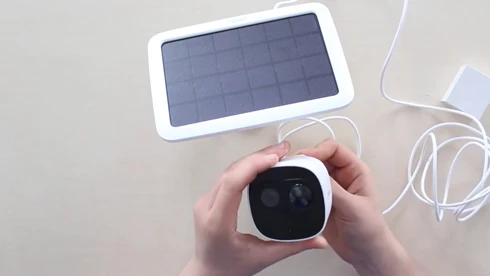
If you are looking for a more sustainable and environmentally friendly way to power your security cameras, you may consider using solar power.
Solar power can be used to power a wide range of devices, including security cameras. To power your camera, you will need the following:
A solar panel(s):
You will need a solar panel or panels to collect the sun’s energy. The size of the panel will depend on the size of your camera and how much power it requires.
Solar Charge Controller:
A solar charge controller is necessary to protect your camera from overcharging. Solar panels transmit electricity to batteries via a solar regulator, a small box that controls the amount of power fed into the batteries.
Solar Battery/Battery Bank:
A solar battery or battery bank is necessary to store the energy collected by the panels. These batteries pack sizes will depend on how much power your camera needs.
Different kinds of batteries are available, such as lead-acid, deep cycle battery, nickel-cadmium, and lithium-ion. You need to choose a battery compatible with your controller.
Security Camera:
Obviously, you will need a solar security camera to power it. Make sure to choose a camera that is compatible with solar power. Moreover, the camera should withstand fluctuations in voltage and current.
You can find several kinds of solar-powered surveillance cameras on the market. Try to find a camera that is easy to install and does not require a lot of maintenance.
DC Converter/Inverter:
If you use solar energy storage to store your solar power, you will need a DC converter/inverter to convert the 12-volt DC from the batteries into the 110-volt AC needed to power most surveillance cameras.
Once you have gathered all of the necessary equipment, it is time to start setting up your DIY solar security camera system.
How to Power a Security Camera Using Solar Panel : Steps to Follow
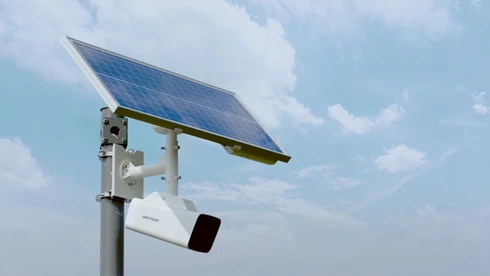
Solar power are a great way to power surveillance cameras without relying on traditional methods like AC or DC power. Using solar power can reduce your carbon footprint and help promote sustainability.
The following steps will help you get started:
- Mount the panels in an area that receives a lot of sunlight. These panels should be facing south in the northern hemisphere or north if you are in the southern hemisphere.
- Run the wire from the panel to the charge controller.
- Mount the controller in a location that is easily accessible.
- Run the wire from the charge controller to the battery pack.
- Mount the battery in a location that is easily accessible.
- Connect the positive and negative terminals on the panel, charge controller, and battery pack.
- Connect the positive and negative terminals on the camera.
- Connect the DC converter/inverter to the battery pack and camera.
- Turn on the controller and check the battery level.
- Install the cameras at the desired location and enjoy 24/7 continuous monitoring of your property.
Following these simple steps will help you set up a solar-powered surveillance system in no time. It is beneficial to the environment and can also reduce your energy costs.
Factors Need to Consider for Powering Security Camera
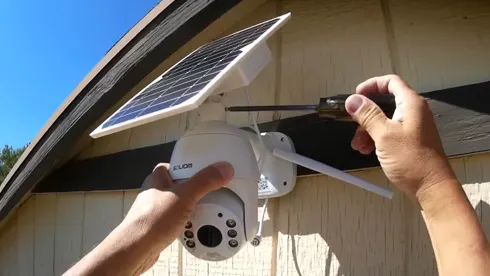
Surveillance system security cameras are a great way to enhance the security of your home or office. While there are many ways to supply power to a camera, using a panel is one of the most efficient and environmentally friendly options.
If you’re considering powering your camera with solar energy, here are some factors:
Location
The first thing you need to consider is where the camera will be installed. Panels work best in areas with ample sunlight. If you live in a sunny location, a panel may be the best way to power your camera.
If you live in a more cloudy or rural area, you may want to consider using an alternate source of power for your camera.
Weather Conditions
Panels rely on direct sunlight to generate power. In areas with frequent cloudy weather or snow, panels may not be the best option for powering your camera.
Size of the Security Camera
These cameras come in a variety of sizes. Before purchasing a solar panel, make sure to measure the size of your camera. The panel should be large enough to generate power for the camera.
Battery Storage Capacity
Even if panels are installed, your security camera may still need a backup rechargeable battery. Ensure the camera has a large enough battery to last through any power outages.
Voltage
It is critical to know what type of power supply you use. This is because if you use a 12V power supply with a 24V camera, the camera will not function properly.
Most security cameras require 12 volts of power to operate. But using a 24 Volt power supply with a 12 Volt camera can damage the device, rendering it inoperable.
Protection from the Elements
Security cameras needs to be protected from the elements. A reliable IP rating will also be necessary for outdoor security cameras. An ingress protection rating refers to how a camera is sealed from moisture, snow, dirt, dust, and other environmental conditions factors.
An IP65 rating is adequate for most environments, protecting the water emitted from a nozzle.
Installation Cost
Installing a solar panel may require the services of a professional. If you’re not comfortable installing the panel yourself, be sure to factor in the cost of professional installation.
Solar security cameras are becoming more and more popular due to their many benefits. They are environmentally friendly, but they can also be more cost-effective.
You can choose the best way to power your camera using solar energy by considering these factors.
Calculating How Much Power You Need
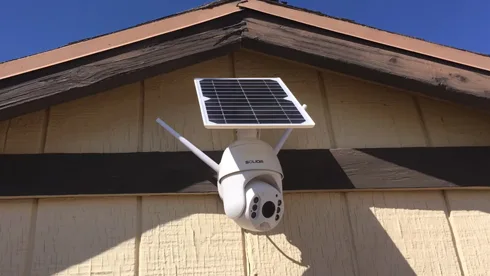
The energy efficiency of surveillance cameras has improved significantly over the past few years. Cameras that draw less than five watts of power are now available on the market.
If you are looking to purchase a low-power surveillance camera, please refer to the chart below:
| Camera Technologies | Consumption of Power on Average |
| Analog Cameras | < 300 mA |
| IP Cameras | 400 – 500 mA |
| Built-in Wireless and Infrared Cloud Cameras | 600 – 700 mA |
Considering how many cloudy days you may have in a row is crucial when you are determining how much power is required by a solar panel and battery. During cloudy weather, your battery will supply power without assistance from the panel.
Tips and Tricks for Using Solar-Powered Security Cameras
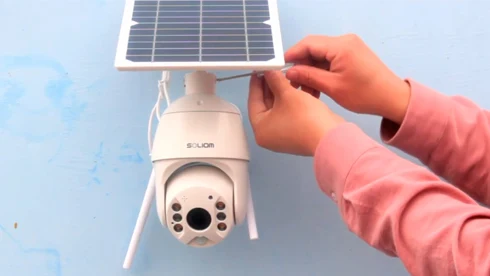
When you have a solar-powered camera, you can do a few things to increase the efficiency of the solar power system:
- Make sure the panels are in direct sunlight. The panels should be installed in an area that will receive plenty of sunlight.
- Keep the battery charged. A fully charged battery can deliver more power for up to 72 hours.
- Use a 24V camera. A 24V camera will require less power than a 12V camera and is more efficient when solar-powered by solar energy.
- Protect the solar panel from the elements. Snow, rain, and sun can all damage the solar panel.
- Use a solar-powered security camera with an IP rating of 65 or higher. This will protect you from the elements and allow you to use the camera in outdoor environments.
- Ensure your camera has a large enough battery to last through any power outages.
- If you live in a cloudy or rural area, consider using an alternate power source for your security camera.
- Protect your security camera from the elements by installing it in weather-resistant housing.
- If you have an outdoor camera, regularly clean the lens to ensure good video quality.
- Keep your security footage by downloading it to a local drive or sd card from an online cloud storage service.
- Regularly back up your footage in case of hard drive failure or theft.
- Consider using a motion-activated recording feature to save disk space and reduce the amount of footage you need to review.
- Use a camera with night vision to capture footage in low-light conditions.
- If you have questions about using your security camera, consult the manufacturer’s support website or contact customer service.
You can keep your security camera running effectively and efficiently using solar power with a bit of preparation. By following these tips, you can help ensure that your property is always protected.
FAQs
Below are some of the most frequently asked questions regarding solar-powered cameras:
01. Can a Solar Panel Power a Security Camera?
Solar panels can be used to power security cameras, but the amount of power required will vary depending on the camera. Some low-power cameras only require a solar panel and battery, while other high-power cameras may require a larger solar panel and more solar batteries.
02. What Voltage Do Security Cameras Use?
Most security cameras use 12 volts, but some newer models use 24 volts. Additionally, some models can support both 12 and 24 volts. Check the specs of your camera to find out what power supply voltage it uses.
03. Do Solar Cameras Need Direct Sunlight?
Solar panels need direct sunlight to work effectively, but the battery can still provide power on cloudy days. In locations with limited exposure to the sun, you should locate the camera on a wall facing south to receive at least six hours of sunlight each day.
04. Can You Mix Wired and Wireless Security Cameras?
Yes, you can mix wired and wireless cameras. However, to ensure the best possible performance, it is recommended that you use all of the same types of cameras (wired or wireless).
In conclusion
solar panels are an excellent way to provide enough power to your camera without having to connect it to a nearby outlet or utility line. Using solar power to run your security camera should be easy and cost-effective if you follow the few steps outlined above.
The advantage of solar-powered security cameras is that you can protect your home, business, or property without worrying about power outages. We hope that this article has provided you with some helpful information about how to power a security camera using solar panel.
With the tips in this article, you can ensure that your solar camera is always performing at its best. You can keep your property safe and secure with a solar-powered security camera with a little preparation.
